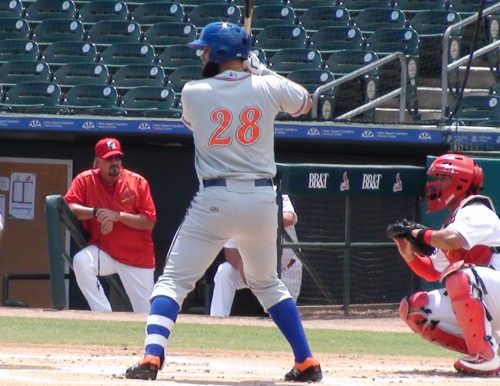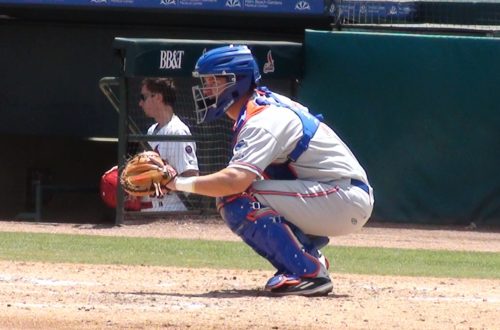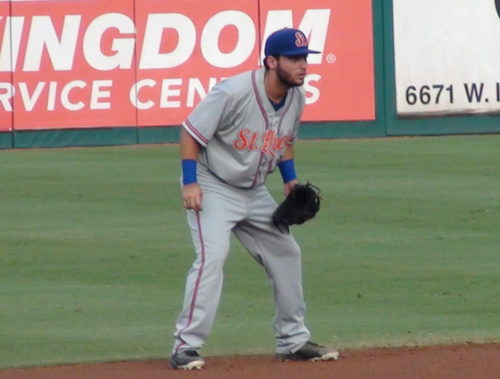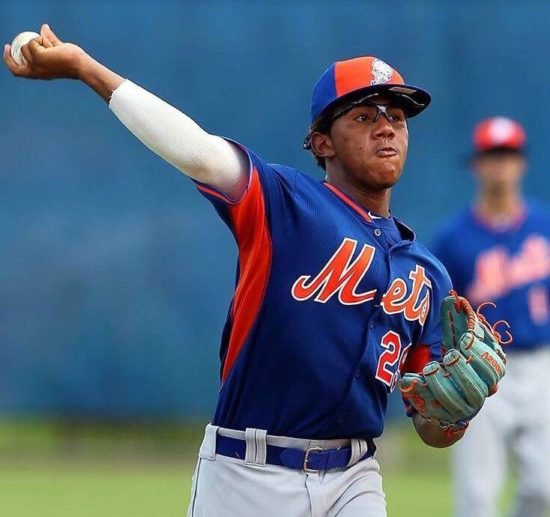
Photo By Ernest Dove
25. OF Wuilmer Becerra
Ht: 6’3” Wt: 225 Level: St. Lucie
B/T: R/R Age: 10/01/1994 (22) Age Dif: -0.8
Acquired: Part of seven player trade from the Toronto Blue Jays
2017 Stats: 93 G, 372 PA, 334 AB, 33 R, 85 H, 12 2B, 2 3B, 3 HR, 30 RBI, 12 SB, 2 CS .254/.323/.329
Previous Rank: 11
Profile: Heading into the 2016 season Becerra was getting hyped as the throw-in flyer prospect that was going to make the R.A. Dickey trade look like an even bigger coup for the Mets organization. He was a power hitting prospect that had a strong arm in right field. Those skills began to shine with Becerra in the Mets organization. That was until last year.
Becerra injured his shoulder during Spring Training, and he attempted to play through the injury. During the season, he failed to hit for power and his once strong throwing arm was gone. With cortisone shots not working, he had season-ending surgery on a torn labrum in his right shoulder in July. With the promise he had shown prior to the surgery, the Mets added him to the 40 man roster to protect him from the Rule 5 Draft.
Unfortunately, Becerra is not yet the player he was before the labrum surgery. For the first 27 games of the season and for 31 of his first 33 games of the season, the Mets used Becerra as a DH. Over that time period, Becerra’s play was not commensurate with a DH or a top prospect hitting just .264/.329/.388 wtih five doubles, a triple, three homers, and 18 RBI.
It is also notable when Becerra has returned to play in the outfield, he has played more left field than right field. Part of the reason for this is he has not seen his arm strength fully return. As a result, he no longer has the strong arm you would want to see from a right fielder. Now, he has played more right field lately, but that is probably more the result of Tim Tebow getting called up to St. Lucie than it is Becerra regaining some of his lost arm strength.
Right now, it is hard to make out what Becerra really is. Arguably, his offensive stats has regressed each and every month this season. He has not hit a home run in his last 247 plate appearances. Over that same stretch, he is striking out 25% of the time. Another troubling sign is that the stats he does have are fueled by a .353 BABIP.
However, it is still too soon to overreact to these issues. As we have seen with pitchers who have had similar surgeries to Becerra, they typically sit out a season because it typically takes them that long to get to full strength. While Becerra may have been cleared for baseball activities, it does not necessarily mean he was at complete strength to play at the level he had played prior to the surgery.
It is very likely Becerra still possess power at the plate and a strong arm in right field to go with better than average speed. Likely, he just needs a full season under his belt to get back to that point.

Photo By Ernest Dove
24. C Patrick Mazeika
Ht: 6’3″ Wt: 210 Level: St. Lucie
B/T: L/R Age: 10/14/1993 (23) Age Dif: 0.2
Acquired: Eighth round of the 2015 Draft from Stetson University
Previous Rank: 44
2017 Stats: 88 G, 366 PA, 313 AB, 40 R, 90 H, 18 2B, 7 HR, 48 RBI, 2 SB, CS, .288/.385/.412
Profile: Since being drafted in the 8th round in the 2015 Draft, the one thing Mazeika has done is hit everywhere the Mets put him. However, he doesn’t just hit, the catcher gets on base. We have seen those offensive skills emerge yet again with Mazeika being named a Florida State Leauge All Star this year. With him, the bat was never the problem. It was his skills behind the plate. It has been an area of focus for the 6’3″ catcher as he told MMN in an exclusive interview earlier this year:
“I’ve improved in every aspect defensively – definitely improved a lot receiving especially this offseason after instructional league. My throwing has improved with better mechanics back there. This offseason I’ve also gotten more flexible and I feel I’m moving better.”
While it can be difficult at times to quantify how a catcher is handling the position, we have seen Mazeika make progress behind the plate. There has been a reduction in his passed ball rate from his struggles in 2015 in Kinsgport. His caught stealing percentage has risen from 25% in his first season to 30% so far this season. More than any stat, the one thing we can point towards is the team primarily using Mazeika as the everyday catcher.
In April and May, Mazeika was splitting time between catcher (31 G) and first base (12 G). Since the Month of June, Mazeika has primarily served as the team’s catcher. Over his last 42 games, Mazeika has caught in 33 games. Part of that has been Peter Alonso not only returning from the disabled list, but also once again hitting like he did in Brooklyn last year. Mainly, the reason is Mazeika has continued to progress defensively behind the plate.
Now, it should be noted with the increased workload, Mazeika’s power numbers have taken a hit. He has gone from a .506 slugging percentage with 15 doubles and six homers to a .298 slugging percentage with three doubles and one homer. The good news here is Mazeika continues to get on base with him having a .379 OPB since June 1st, and he has progressed defensively.
Ultimately, there is still room for Mazeika to grow. He needs to continue to get better behind the plate, and he has to be able to show the Mets he is not going to wear down while withstanding the rigors of being a team’s everyday catcher. Still, he has shown the ability to hit very well, and he has also shown the ability to improve behind the plate.

23. LHP P.J. Conlon
Ht: 5’11″ Wt: 190 Level: Binghamton
B/T: L/L Age: 11/11/93 (23) Age Dif: -1.4
Acquired: Drafted in the 13th round of the 2015 Amateur Draft from University of San Diego
Previous Rank: 23
2017 Stats: 7-7, 3.68 ERA, 19 G, 19 GS, 115.0 IP, 1.243 WHIP, 7.1 K/9
Profile: Conlon isn’t what we’ve come to expect from a Mets pitching prospect. Instead of stepping on the mound with wild hair and throwing an upper 90s fastball, Conlon is a control pitcher who rarely breaks 90 MPH with his fastball, and he uses a very good change-up to get batters out.
Typically, this type of prospect does not rank highly on prospect sheets, but it has been hard to argue with the results. In his two plus years in the minors, Conlon had posted a 1.47 ERA with a 5.07 K/BB ratio. Certainly, the Mets took notice, and the team gave him a long look this Spring Training as a potential left-hander out of their bullpen. Ultimately, the team decided to go with Josh Edgin as the second LOOGY and assigned Conlon to Binghamton.
The best way to describe Conlon’s year is inconsistent. While he has been twice named the Eastern League’s Pitcher of the Week, and he was named to the All Star team, Conlon has had a few clunkers this season. In six separate starts this year, the left-hander has allowed five plus earned runs. Entering this season, he had only done that once. For that matter, Conlon had only allowed three plus earned runs only twice in his professional career. What is truly bizarre is how these bad starts have been spread around this season. He has had at least one start allowing at least five earned runs in every month this season.
With that said, it does seem like Conlon has been making the necessary adjustments to pitch well at this level. In his last four starts, Conlon has pitched at least six innings. In three of those starts, he allowed one run or less with his having a complete game three hit seven inning shutout. One of the main reasons for this is C0nlon has been cutting down on the fly balls. For the first three months of the season, 60% of the balls put in play against him went in the air. In the Month of July, that rate is down to 51%, which is much closer to the 55% it was last year when he was the breakout pitching prospect in the Mets organization.
Ultimately, when you don’t get your fastball into the 90s, there are going to be a lot of questions about your viability as a future major leaguer. While Conlon may not have the outstanding results he had last year, he is showing the Mets he has the ability to adjust to the league and pitch better. This may tell us more about Conlon that anything he did last year.

Photo By Ernest Dove
22. 2B Michael Paez
Ht: 5’8″ Wt: 175 lbs Level: Columbia & St. Lucie
B/T: R/R Age: 12/8/1994 (22) Age Dif: -0.8 (St. Lucie)
Acquired: 4th Round in 2016 Draft from Coastal Carolina University
Previous Rank: 50
2017 Stats: 94 G, 390 PA, 333 AB, 44 R, 87 H, 26 2B, 2 3B, 10 HR, 58 RBI, 9 SB, 7 CS, .261/.349/.441
Profile: Paez was part of a trio of interesting shortstop prospects the Mets drafted last year. Ultimately, the Mets decided between his size and his arm strength, the Mets moved him to second base. Between the transition to second base and the transition to professional baseball, Paez did not show off the bat that led the Mets to draft him in the fourth round last year.
The starting second baseman in the Sally League All Star Game has shown off that offensive potential this season. In 64 games with Columbia, Paez hit .290/.376/.509 with 21 doubles, two triples, eight homers, and 43 RBI. For batters with at least 250 plate appearances in the Sally League, Paez’s 151 wRC+ was the fourth best in the league, and the best among middle infielders. He was also top five in the league in OBP (5th), SLG (5th), OPS (4th), and ISO (5th). With numbers like that, he all but forced the Mets to promote him to St. Lucie.
At St. Lucie, the results have not been as good with Paez hitting just .202/.291/.303 in 30 games. There could be a number of reasons for this. It could be his playing his first full season in professional baseball. It could be his BABIP dropping from a high .345 to an extremely low .212. It could be the better competition, or just part of the natural ebbs and flows a player experiences over the course of a season and in his development.
Unlike last year when Paez predominantly played second, the Mets have been rotating Paez around the infield. He has played just as many games at second base (42) as he has played at other infield positions (SS – 22 G; 3B – 20 G). What is unclear at this point is if the Mets are doing this with Paez because of a new organization philosophy to make all of their prospects more versatile in the field, or if this is the result of the Mets not quite being clear at which position they foresee Paez will be. Ultimately, with his range and arm, he is probably best suited to second base.

21. SS Gregory Guerrero
Ht: 6’1” Wt: 180 Level: Gulf Coast
B/T: R/R Age: 1/20/1999 (18) Age Dif: -1.4
Acquired: Signed as an IFA in 2015 for $1.5 million bonus
Previous Rank: 19
2017 Stats: 22 G, 90 PA, 84 AB, 12 R, 19 H, 2 2B, 3B, 6 RBI, SB, CS, .226/.270/.274
Profile: While his cousin Vladimir Guerrero, Jr. was playing in the Future’s Game and his uncle Vladimir Guerrero is awaiting the new Hall of Fame vote, Gregory was making his stateside debut.
More than his pedigree, what gets you excited about Guerrero as a prospect is he not only has the skills to play the game, he knows how to play the game well possessing a high baseball IQ. He is fast on the basepaths and is projected to steal double digit bases. At the plate, he has previously shown a knack for barrelling baseballs. This is in large part due to his bat speed and raw power at the plate. He also has a good knowledge of the strike zone as evidenced by his 8.6% walk rate.
With all that talent, you would expect for Guerrero to have better stats. One thing that has been pointed out is at times he tends to get big at the plate trying to hit homers instead of letting his natural ability do the work for him. Part of the reason is he is still young for his level. There is also something to be said for your first experience in both professional baseball as well as your first experience living away from home. There is also the fact Guerrero is a lanky kid who is still growing into his frame.
As he matures physically, there is a question of where he will eventually wind up. Right now, he certainly has the range and speed to play short. This year, the Mets have had him split time between both middle infield spots. However, with how many anticipate he will mature physically coupled with that outstanding arm, many believe he will find a home either at third base or any one of the three outfield positions. While you could make the argument he could stick as a bigger offensive minded shortstop, with the Mets being loaded at the shortstop position from an organizational standpoint, a move to a different position may just be inevitable for him.
Ultimately, the Mets have a very talented player in Guerrero who really has no definable ceiling at the moment. Between his lineage, his baseball IQ, and his natural talent, he could quickly progress to become one of the very best prospects in the Mets farm system. The key for that happening is the young player putting it all together. So far, he hasn’t done that, but there is still plenty of time for him to do so.
Previous Posts
